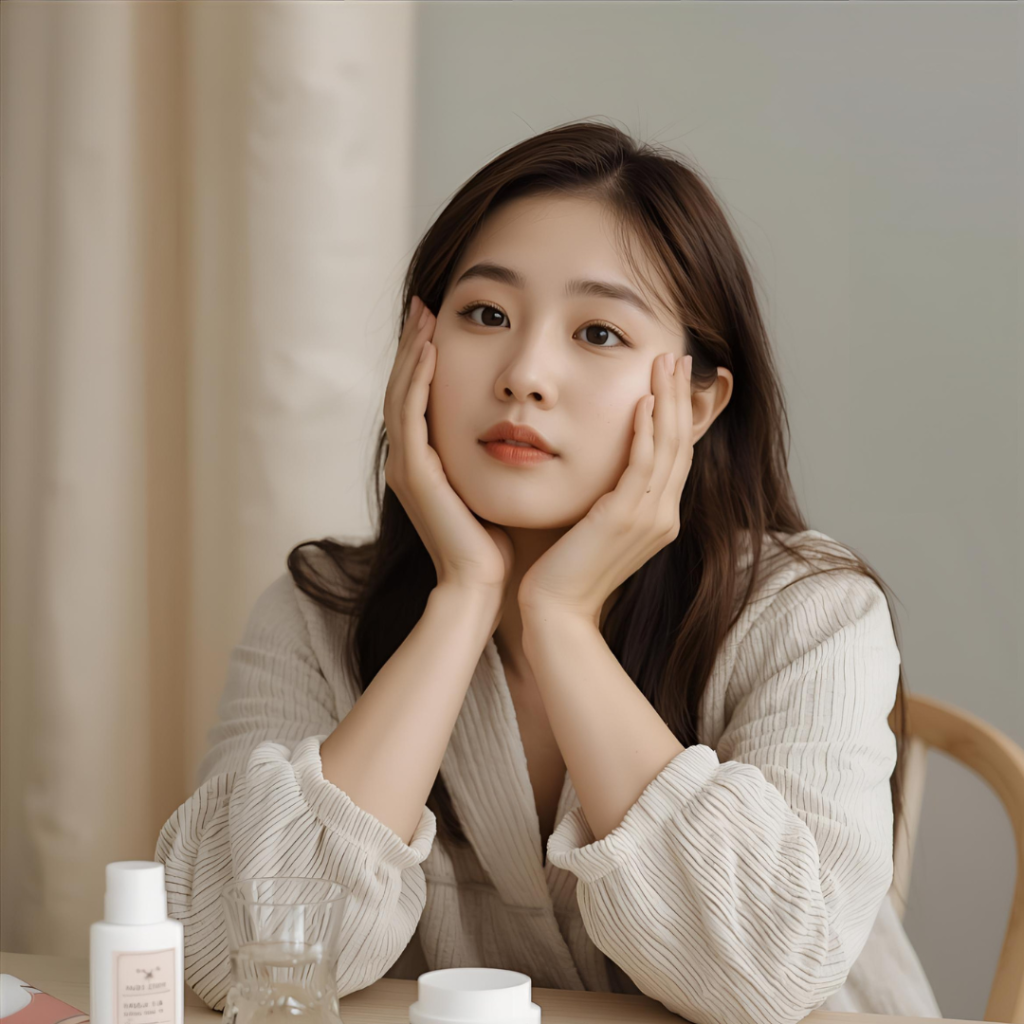Korean Skincare Routine for Sensitive Skin
A Korean skincare routine for sensitive skin carries the risk of redness, irritation, or breakouts.
Korean sensitive skin step-by-step gradual improvement through layering lightweight products
that work with your skin’s natural function. This is beneficial for those dealing with sensitivity and redness.

K-beauty philosophy for sensitive skin, understanding
What makes skin sensitive?
Sensitive skin is not a concern of cosmetics; it’s a condition where your skin barrier is more reactive
to ingredients, stress, and environmental triggers. Include common signs like tightness after
cleansing, redness, and burning sensations.
Korean sensitive skin care
Causes common triggers
Sensitive skin can be affected by numerous factors: extreme temperature, pollution, over-exfoliation, and alcohol-based products. You understand the first step toward effectively managing sensitivity.
Why does sensitive skin work for Korean skin care?
The Korean beauty routine for sensitive skin is constructed on three principles: hydration-focused layering, barrier strengthening, and gentle formulation. Korean products make minimal ingredient lists, avoid harsh sulfates and high concentrations of aggressive actives, and avoid artificial fragrance. They focus on tiger grass products, snail mucin for sensitive skin, and aloe vera for Korean care solutions.
The first step is essential
Korean 10-step routine for sensitive skin: simple start. Basic steps: moisturizer, sunscreen, and
cleanser. Korean skin care routine minimally allows for establishing and identifying any
problematic products before adding more complex ingredients.
Avoid products
Korean skincare routine, building your fragrance-free routine, and avoiding products:
- SLS, like harsh sulfates, acid, or retinoids, at high concentrations
- SD alcohol or alcohol sulfates (irritating and drying)
- Essential oils and synthetic fragrances
- Patch testing importance
Korean calming skincare products before introducing any new ones, always patch test. 24-48 hours
Apply a small amount behind your ear or on your inner forearm.
Formulations ph- pH-balanced
Korean pH-balanced cleansers are one of K-beauty’s greatest contributions and are an emphasis. Using pH-balanced products reduces irritation and sensitivity.
10-step Korean skin care routine for sensitive skin
Step 1: Oil-Based Cleanser
Purpose: sunscreen, oil-based impurities without stripping, and gently removes makeup. For dry
skin 30-60 minutes massage before water rinsing.
Step 2: Korean face wash for sensitive skin (water-based cleanser)
Purpose: removes residual cleanser and water-based impurities.
Korean sensitive skin cleansers with low pH, gel texture, or cream are always better choices.
rather than others. Cleanser should feel no tightness or squeaky feeling post-wash, and
Be comfortable.
Step 3: Exfoliant
Purpose: improve product absorption and remove dead skin cells.
For sensitive skin, it should be used infrequently and gently, mostly once or twice a week, mostly. Work on the
surface without causing irritation, which is a larger molecule.
Step 4: toner for Korean sensitive skin
Purpose: hydrates, prepares skin for subsequent products, and balances pH.
They absorb and avoid friction from cotton pads. Toners are nothing like the Korean
and the astringent Western version.
Step 5: Essence
Purpose: promotes skin repair and provides deep hydration.
K-beauty is the heart essence. For non-irritating skincare routine goals, choose essences with
bubble ingredients (like galantamine or bifida) or barrier-repairing ceramide in Korean skincare
products.
Step 6: Treatment
Purpose: Targets barrier damage and specific concerns like redness or hydration.
For Korean skin care for redness and sensitivity, look for serums featuring:
- Centella Asiatica: wound-healing and anti-inflammatory.
- Niacinamide (4-5%): Barrier, reduces redness, strengthens.
- Snail Mucin: Hydrates and soothes the repair
- Panthenol: calming and deeply hydrating
Step 7: Sheet Mask (Korean Sheet Masks for Sensitive Skin)
Purpose: soothing boost and intensive hydration.
The Korean sheet mask for sensitive skin is used 2-3 times weekly for 15-20 minutes. Mask made with simple ingredients like hyaluronic acid, aloe vera, and centella. Avoid mask essential oil, fragrance, and alcohol.
Step 8: Eye Cream
Purpose: Migration or irritation delicate or address eye area concerns.
Choose ceramides, caffeine, and fragrance-free formulas with peptides. The eye area’s skin may be irritated or particularly vulnerable.
Step 9: moisturizers for Korean sensitive skin care
Purpose: Provides long-lasting hydration and seals layers in all porous materials.
Gel-creams or lightweight lotions with hyaluronic acid and centella for Korean oily sensitive
skin.
Step 10: Sunscreen for Korean Sensitive Skin (SPF)
Purpose: The cause of inflammation and premature aging protects against UV damage.
A morning routine is essential! Korean lightweight Morning routine essentials have sun protection
with their non-greasy and elegant formulas. For sensitive skin, choose mineral (physical)
sunscreens with titanium dioxide, zinc oxide, or newer organic filters specifically tested for
sensitivity.
Korean Skincare Routines for Sensitive Skin simplified
5-Step Korean Skincare Routine for Beginners with Sensitive Skin
Morning:
- Sunscreen
- Moisturizers
- Hydrating toner
- Water-based cleanser
Evening:
- Hydrating toner
- Treatment serum
- Oil cleanser
- Water-based cleanser
- Moisturizer
Korean Skincare Routine Morning and Night
Morning Routine: Hydration and protection
Your Korean skincare routine morning focuses on daily aggressors, protecting skin from:
- Eye cream
- Hydrating toner
- Lightweight essence
- Vitamin C serum (if tolerated—use stabilized versions)
- Eye cream
- Light moisturizer
- Sunscreen (non-negotiable)
Time required: 10-15 minutes
Evening Routine: regeneration and Repair
A Korean skincare routine at night emphasizes repair while you sleep:
- Essence Oil cleanser (makeup removal)
- Eye cream
- Water-based cleanser
- Rich moisturizer or sleeping pack
- Exfoliant (1-2x weekly only)
- Hydrating toner (multiple layers)
- Treatment serum
- Sheet mask (2-3x weekly)
Time required: 20-30 minutes (45 with sheet mask)
Different Sensitive Skin Types for Korean Skincare
Dry Sensitive Skin for Korean Skincare
Focus: Barrier repair and hydration
Your Korean skincare for sensitivity and dryness should feature:
- Facial oils (rosehip, argan—if tolerated)
- Ceramide-rich products throughout routine
- Humectant-packed toners and essences (hyaluronic acid, glycerin)
- Occlusive sleeping packs (containing squalane, shea butter)
- Humectant-packed toners and essences (hyaluronic acid, glycerin)
- Facial oils (rosehip, argan—if tolerated)
Avoid: Foaming cleansers, astringent ingredients, over-cleansing
Key products: Cream cleansers, thick essences, ceramide serums, rich creams, sleeping masks
Korean Skincare for Oily Sensitive Skin
Focus: Lightweight hydration without clogging pores
Your soothing skincare routine should include:
- Gel- or water-based products that absorb quickly
- Non-comedogenic oils (like squalane or jojoba)
- Mattifying yet hydrating formulas
- Light exfoliation (PHA) to prevent congestion
Avoid: Heavy creams, coconut oil, pore-clogging ingredients
Key products: Gel cleansers, watery toners, light serums, gel-creams, oil-free sunscreens
Korean Skincare for Combination Sensitive Skin
Focus: Balancing different zones without irritation
Your approach:
- Zone-specific application (richer products on dry areas, lighter on oily zones)
- Balancing toners and essences that normalize sebum production
- Adjustable moisturizer based on seasonal needs
Tip: Use different moisturizers on different areas—gel-cream on the T-zone, richer cream on
cheeks.
Korean Skincare for Acne-Prone Sensitive Skin
Focus: Gently without inflammation, Clearing breakouts
Acne-prone sensitive skin for Korean skincare:
- Patience with actives (introduce slowly, use low concentrations)
- Gentle BHA alternatives (betaine salicylate—less irritating than salicylic acid)
- Non-comedogenic everything (check ingredients)
- Anti-inflammatory ingredients (centella, tea tree, niacinamide)
Avoid: physical exfoliants, Harsh spot treatment products with added fragrance
Key products: BHA toners (1-2x weekly), Low-pH cleansers, niacinamide serums, lightweight
Non-comedogenic moisturizers. When experiencing a sensitivity flare or breakout emergency:
Frequently Asked Questions
1. How long does a Korean sensitive skincare routine for sensitive skin take to see results?
Reduced redness around 3-4 weeks, but mostly people notice improved hydration within 1-2
weeks. If you need luminous results, use Korean skin care products for 6-8 weeks.
Remember that sensitive skin requires patience.
2. Can I use all 10 steps if I have sensitive skin?
Yes, but gradually start. Begin with 4-5 steps (moisturize, SPF, cleanse, and tone), and slowly add masks.
essence and add treatments.
3. Can I mix Korean skincare with Western products?
Absolutely! The Korean barrier repair routine philosophy works beautifully with evidence-based
Western skincare. You might use a hydrating layer and a Korean double cleanse, then
Incorporate a prescription treatment or Western retinol serum.
4. Is the 10-step Korean routine essential for acne-prone, sensitive skin?
Not necessarily. For Korean skincare for acne-prone, sensitive skin, a targeted 5-7 step routine
with the right ingredients (serum, sunscreen, cleanser, and lightweight moisturizer). The multi-
Step approach values lie in gentle products, not simply.


